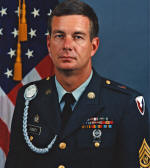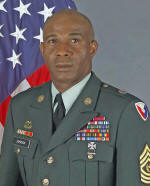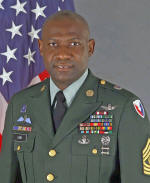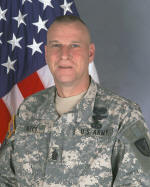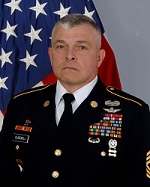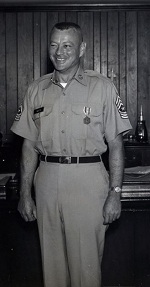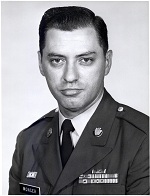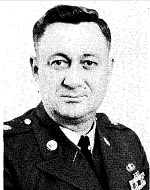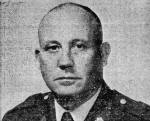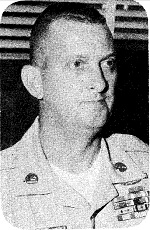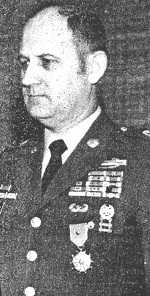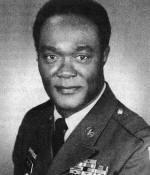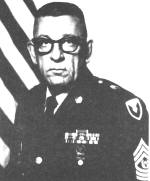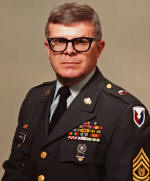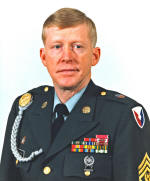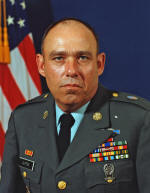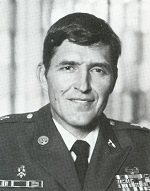Aviation & Missile Command (AMCOM)
CSM Benjamin F. Sundey - July 1997 - September 1998
|
CSM Benjamin F. Sundey was born on 30 August 1954 in Perry, Florida. He entered the Army on 22 June 1972 as a 55B10, Ammunition Operations Specialist. Among the military schools he attended were Ammunition Operations Specialist, Redstone Arsenal, Alabama; Primary Leadership Development Course, 7th Army Noncommissioned Officer (NCO) Academy; Advanced NCO Course, Redstone Arsenal, Alabama; and the U.S. Army Sergeants Major Academy, Fort Bliss, Texas. Sundey’s military assignments included: Ammunition Operations Specialist, 608th Ordnance Company, Fort Benning, Georgia; Ammunition Operations Specialist, U.S. Army Infantry Board, Fort Benning; Section Chief and Platoon Sergeant, 64th Ordnance Company, Fischbach, Germany; Platoon Sergeant, 4th Student Company, Redstone Arsenal; First Sergeant, 70th Ordnance Company, Cakakli, Turkey; Operations Sergeant, 4th Student Company, Redstone Arsenal; Ammunition NCO in Charge (NCOIC), G-4, Headquarters and Headquarters Company, I Corps, Fort Lewis, Washington; Ordnance Enlisted Advisor, Readiness Group Los Angeles, 6th U.S. Army, Lost Alamitos, California; First Sergeant, Company B, 73d Ordnance Battalion, Redstone Arsenal; CSM, 84th Ordnance Battalion, Muenchweiler, Germany; and CSM for the U.S. Army Test, Measurement, and Diagnostic Equipment Support Group, Redstone Arsenal. He served as the last U.S. Army Missile Command (MICOM) CSM from October 1994 to July 1997, at which time he became the first AMCOM Command Sergeant Major. Sundey served in this post until his retirement in October 1998, after more than 26 years service. |
CSM Roscoe L. Johnson, Jr. - December 1998 - June 2003
|
CSM Roscoe L. Johnson, Jr., was born in Cleveland, Tennessee. He was drafted into the Army in December 1970 and attended Basic Training at Fort Knox, Kentucky. He completed on-the-job training at Fort Meade, Maryland. During more than 30 years service, Johnson held a variety of positions to include: Platoon Sergeant, First Sergeant, Sergeant Major (SGM), and CSM of the 46th Forward Support Battalion, 548th Corps Support Battalion, 10th Mountain Division Support Command (DISCOM), and the 45th Corps Support Group (Forward), Schofield Barracks, Hawaii. In addition, he served in Alaska; Germany; Sinai-Egypt; Fort Bragg, North Carolina; Fort Bliss, Texas; Lafayette, Indiana; Fort Drum, New York; and Schofield Barracks, Hawaii. He also deployed as the CSM of the 46th Forward Support Battalion and the 548th Corps Support Battalion to Somalia and Haiti. Johnson became AMCOM CSM in December 1998. He served in this position until his retirement in June 2003. Military decorations held by CSM Johnson included the Legion of Merit with one Oak Leaf Cluster, the Meritorious Service Medal with three Oak Leaf Clusters, the Defense Joint Commendation Medal, the Army Commendation Medal with two Oak Leaf Clusters, the Good Conduct Medal (8th award), the National Defense Service Medal with Service Star, the Armed Forces Expeditionary Medal, the Humanitarian Service Medal, the Noncommissioned Officers Development Ribbon (Number 4), Army Service Ribbon, the Overseas Service Ribbon, the United Nations Medal, and the Multinational Force and Observer Medal. He has been inducted into the Distinguished Order of Saint Martin and the International Who's Who of Public Service. On 16 May 2002, he was recognized as a Distinguished Member of the Quartermaster Regiment during Quartermaster Regimental Week activities at Fort Lee, Virginia. |
CSM Gregory Lunn - July 2003 - December 2005
|
CSM Gregory Lunn is a native of Baltimore, Maryland. He entered the Army in October 1977, in the field of Aviation Operations. His first assignment was with the First Squadron (Air), 17th Calvary, 82d Airborne Division, Ft. Bragg, North Carolina, where he served as the Flight Operations Specialist, Operations Sergeant and Flight Operations Chief, in Headquarters and Headquarters Troop, Command Aviation Platoon until January 1984. Lunn's next assignment was to Grafenwohr, Federal Republic of Germany (FRG), from March 1984 to April 1986, where his positions included Operations Sergeant and Airfield NCO in Charge (NCOIC) for 7th Army Training Command. His next assignment was to Wiesbaden, FRG, from April 1986 to May 1989, where his positions included Assistant Instructor for Flight Operations and Operations NCOIC for U.S. Army Europe, Aviation Safety and Standardization Board, FRG. After his tour in Germany, Lunn was assigned to Task Force 160, Fort Campbell, Kentucky, where he served as the Operations NCOIC for C Company; Task Force Headquarters Operations NCOIC; Operations NCOIC, 1st Battalion, 160th Special Operations Aviation Regiment (SOAR); and First Sergeant, Headquarters and Headquarters Company, 1st Battalion, 160th SOAR (A). He was then assigned to the U.S. Notice to Airmen (NOTAM) Office, Washington, D.C. from January 1994 to October 1994, where he served in a Joint Service billet as the U.S. Army NOTAM Coordinator to the Federal Aviation Administration, Washington D.C. Returning to Special Operations from November 1994 to July 1996, Lunn served as the Aviation Operations Sergeant in 3d Battalion 160th SOAR (A) at Savannah, Georgia, and Operations SGM for the 160th SOAR (A), Fort Campbell. His next assignment was to the 229th Attack Helicopter Regiment, Fort Bragg, North Carolina, from July 1997 to November 1997, where he served as the Rear Detachment SGM and Operations SGM. Lunn was then assigned as the 82d Aviation Brigade Operations SGM from November 1997 to April 1999. From May 1999 to May 2000, he served in Korea as the CSM for the 164th Air Traffic Services Group, 17th Aviation Brigade. He was then assigned as the CSM for 1st Battalion (Attack) Aviation Regiment, 82d Aviation Brigade, 82d Airborne Division. His last assignment before transferring to Redstone Arsenal, Alabama, was CSM for the 25th Aviation Brigade, 25th Infantry Division, Hawaii. Lunn served as AMCOM CSM from July 2003 to December 2005. He was the first aviation SGM to ever serve as CSM for AMCOM and Redstone Arsenal. On 19 December 2004, he became the Senior Enlisted Advisor at the U.S. Transportation Command, a joint four-star command at Scott Air Force Base, Illinois. He is a graduate of Primary Leadership Development Course, Advanced NOC Course, Aviation Safety Prevention Management Course, Battle Staff Course, Jump Master Course, the First Sergeant Course, Survival, Evasion, Resistance and Escape (C) Course, Sergeant Major Academy Class 47 and the CSM (D) Course. He also holds an Associates degree in General Studies from Austin Peay State University. Lunn’s awards and decorations include the Legion of Merit, Meritorious Service Medal with four Oak Leaf Clusters, Joint Service Commendation with one Oak Leaf Cluster Army Commendation Medal with four Oak Leaf Clusters, Joint Service Achievement Medial, Army Achievement Medal with five Oak Leaf Clusters, the Master Parachutist Badge, Master Aviation Badge, Australian and British Parachutist Wings, and the Honorable Order of St. Michael (Bronze) Award. |
CSM Ricky P. Yates - January 2006 - April 2012
|
CSM Ricky P. Yates was born on 15 December 1959 in Chattanooga, Tennessee. He was raised in Blount County, Alabama and attended J.P. Pennington High in Blount County and Guntersville High School in Marshall County. He is a graduate of Rossville Hill High School in Rossville, Georgia. He earned an Associates Degree in Supervisory Leadership from Hawaii Pacific University, Honolulu, Hawaii. Since joining the Army in June 1977, Yates has held numerous leadership positions which include: Squad Leader, Section Sergeant, Platoon Sergeant, First Sergeant, Operations SGM, Battalion CSM for the 1-17th Calvary Squadron, 2-82d Aviation Brigade, 505th Parachute Infantry Regiment, 3-229 Aviation Regiment/159th Aviation Battalion, and Task Force 118 Fort Bragg. He is currently the CSM for AMCOM, Redstone Arsenal, Alabama. His other career assignments include the 82d Airborne Division, 82d Aviation Brigade, 25th Infantry Division, 1-25th Aviation Battalion (Hawaii), 501st Aviation Battalion (Germany), and the 2-9th Calvary Squadron, Hunter Army Airfield (HAAF) Savannah, Georgia. Throughout his career Yates has pursued military education and training. He has completed Basic Airborne School, Jumpmaster School, Instructor Training Course and the Jungle Warfare School. He has also attended and graduated all NCO developmental schools as well as attended Class #49 of the U.S. Army Sergeants Major Academy, Ft. Bliss, Texas. His awards and decorations include the Bronze Star Medal, Meritorious Service Medal (with four Oak Leaf Clusters), Air Medal, Army Commendation Medal (with nine Oak Leaf Clusters), Army Achievement Medal (with two Oak Leaf Clusters), Good Conduct Medal – ninth Award, National Defense Service Medal, Armed Forces Expeditionary Medal, Global War on Terrorism Expeditionary Medal and Global War on Terrorism Service Medal, NCO Development Ribbon (with Numeral 4), Army Service Ribbon, Overseas Ribbon, Kuwait Liberation Ribbon, Joint Meritorious Unit Medal, Combat Action Badge, Master Parachutist Badge, Master Aviation Badge, German Parachutist Wings, Honorable Order of St. Michael (Silver) Award, Order of St. George Award, and the Order of St. Barbara Award. |
CSM Tod L. Glidewell - April 2012 - Present
|
Command Sergeant Major Glidewell entered the United States Army in July 1981, and completed Basic Training at Fort Jackson, SC. After completion of basic training, he attended Advanced Individual Training at Fort Eustis, VA, where he completed the UH-60 Helicopter Repairman course. CSM Glidewell’s assignments include Crewchief, Fort Devens, MA; Section Sergeant, 210th Aviation Battalion, Fort Kobbe, Panama; Instructor/Writer, 1/10th Aviation Battalion, Fort Rucker, AL; Platoon Sergeant 2/2nd Aviation Battalion Camp Stanley, Republic of Korea; Platoon Sergeant, 9/101st Aviation Regiment, EO Advisor, United States Army Garrison, First Sergeant, Alpha and later Delta Company, 4/101st Aviation Regiment, Fort Campbell, KY; First Sergeant, Aviation Company, 1st Support Battalion, El Gorah, Egypt; First Sergeant Bravo Company and later Operations Sergeant, 8/101st Aviation Regiment, Fort Campbell, KY; United States Army Sergeants Major Academy, Fort Bliss, TX; Battalion CSM, 8/101st Aviation Regiment, Brigade CSM, 101st Combat Aviation Brigade, Fort Campbell, KY; CSM, U.S. Army Combat Readiness/Safety Center, Fort Rucker, AL, and the Aviation Branch CSM at Ft. Rucker in May 2009. He served as the AMCOM Command Sergeant Major from April 2012 to Oct. 2014, and retired from active Army service thereafter. CSM Glidewell has attended over 30 military and civilian courses to include all levels of the Noncommissioned Officer Education System including the First Sergeant Course, Defense Equal Opportunity Course, Technical Inspector Course, Air Assault School, Battle Staff and he holds a Bachelor of Science Degree from Excelsior University. CSM Glidewell is a graduate from the United States Army Sergeants Major Academy, Class 50. CSM Glidewell’s awards and decorations include the Legion of Merit (Two Oak Leaf Clusters), the Bronze Star Medal (One Oak Leaf Cluster), the Defense Meritorious Service Medal, the Meritorious Service Medal (Two Oak Leaf Clusters), the Army Commendation Medal (Fourth Oak Leaf Clusters), the Army Achievement Medal (One Silver Oak Leaf Cluster), the Good Conduct Medal (Tenth Award), the National Defense Service Medal, the Iraq Campaign Medal (three bronze stars), the Global War on Terrorism Expeditionary Medal, the Global War on Terrorism Service Medal, the Korean Defense Service Medal, the Humanitarian Service Medal, the Noncommissioned Officers Professional Development Ribbon (Fourth Award), the Army Service Ribbon, the Overseas Service Ribbon (Fourth Award), multinational Force and Observers Medal (Second Award) and Meritorious Unit Award (Two Oak Leaf Clusters). CSM Glidewell also holds the Combat Action Badge, the Master Aviation Badge and the Air Assault Badge. CSM Glidewell is married to Toni Glidewell and they have three children. |
Missile Command (MICOM)
SGM Roland. J. Martin - June 1964 - June 1966
|
Born and raised in Madawaska, Maine, on the border between the United States and Canada, Roland Joseph Martin was the first soldier to hold the rank of Sergeant Major (SGM) for the Missile Command. Promoted by MG John G. Zierdt, Martin was one of nine non-commissioned officers (NCOs) to achieve the SGM rank on the same day at Redstone Arsenal, which was “pretty unique,” recalled Martin in an interview conducted in 2007. Martin began his Army career in March 1945. After finishing basic training, he attended counterintelligence school and worked in the intelligence field for about eight years. He deployed twice to Korea during the war as well as served two tours in Europe before coming to Redstone Arsenal in May 1960. Martin was assigned to the predominantly civilian installation because he had put in for a transfer to Fort McPherson, Georgia, or elsewhere in the Third Army area, when he filled out his “dream sheet” (i.e., preference statement). He first served as the assistant to the Chief of Security for the Army Rocket and Guided Missile Agency (ARGMA) before he became the Operations Sergeant for the Troop Command under the Army Ordnance Missile Support Agency (AOMSA). Martin then served as the First Sergeant for ARGMA, where he was in charge of about 125 Scientific and Engineering (S&E) personnel. The latter were draftees whose educational and professional expertise as engineers, chemists, mathematicians, physicists, etc. placed them in a specialized Army MOS designed to fully utilize their unique training and skills for the advancement of research and development in the rapidly expanding field of Army rocket and guided missile weapons. In February 1962, Martin was selected as the Administrative Supervisor for the Army Ordnance Missile Command (AOMC) Chief of Staff Office and remained in that position after the standup of MICOM in August 1962. He served in that capacity until June 1966, during which time he attained the rank of Sergeant Major for MICOM. As part of his new duties, SGM Martin spent much more time among the command’s troops than before, although he was still frequently in his office in the Command Group suite on the second-floor “A” wing of then-Headquarters Building 5250. Martin left Redstone Arsenal in 1966 to serve a third tour in Korea. He retired from the Army in February 1969. |
SGM John W. Monger - July 1966 - January 1969
|
SGM John W. Monger, a native of Lenoir City, Tennessee, began his military career in the U.S. Navy in 1949. After a break in service, he enlisted in the Army. During his 20 years of service he had two assignments in Korea and a short assignment in Japan, but he spent the bulk of his career at Redstone Arsenal. SGM Monger’s first assignment at Redstone lasted 9 years. He spent his second tour in Korea as part of the 1st Cavalry Division then returned to the arsenal. On both assignments in Korea he earned the Army Commendation Medal, giving him two Oak Leaf Clusters, one of which was awarded at Redstone Arsenal in 1962. He retired from active duty in February 1969. |
CSM John W. Crawford - April 1969 - March 1970
|
CSM John W. Crawford was born in Pisgah, Alabama. He joined the Army in 1949 and filled assignments in Germany, Korea, Vietnam, and the United States. Prior to his assignment to Redstone Arsenal, Crawford served as SGM for G-1, Personnel, Planning, and Administration with Headquarters, XVIII Airborne Corps, Fort Bragg, North Carolina. He also qualified as a parachutist. CSM Crawford left Redstone Arsenal in March 1970 for an overseas assignment. |
CSM Charles A. Havner - March 1970 - June 1973
|
A native of Garden City, Kansas, CSM Charles A. Havner entered the Army in 1946. He received his basic training at Fort McClelland, Alabama. A veteran of 27 years of service, he served overseas in Korea, Germany, and Vietnam. He was also assigned to Fort Knox, Kentucky, and Fort Benning, Georgia. Before coming to Redstone Arsenal, Havner served with the 4th Infantry in Vietnam. Havner held the Bronze Star, the Air Medal with five clusters for duty in Vietnam, the Army Commendation Medal with two clusters, and the Korean Occupation Medal. |
CSM Arthur R. Senkewich - June 1973 - July 1975
|
At the time of his selection, CSM Senkewich was a veteran of 25 years service with four tours of duty in Vietnam and three tours in Korea. In addition to his overseas duty, Senkewich served at Fort Dix, New Jersey; Fort Campbell, Kentucky; Fort Bragg, North Carolina; Fort Devens, Massachusetts; and Fort Richardson, Arkansas. During his military career, Senkewich was awarded the Bronze Star (with one Oak Leaf Cluster), the Air Medal for service in Vietnam, the Meritorious Service Medal, and the Army Commendation Medal (with two Oak Leaf Clusters). |
CSM Leroy A. Arceneaux - July
1975 - January 1978*
|
A First Sergeant at age 19 and a CSM at 30, CSM Leroy A. Arceneaux was believed in 1975 to be the youngest soldier ever promoted to the Army’s top enlisted rank. In addition, only a few other CSMs at that time in the entire Army spent more years at the top than CSM Arceneaux. Before coming to Redstone Arsenal, Alabama, he served as CSM of the Recruiting Command at Fort Sheridan, Illinois. CSM Arceneaux held the Legion of Merit, three Meritorious Service Medals, and three Purple Heart citations, plus numerous other decorations. He twice declined battlefield commissions because of what he felt was too great a disparity between his own educational level and that of those who would have been his officer peers.
On his last day of duty before
he retired in January 1978, CSM Arceneaux received the Legion of Merit for
exemplary professional competence, astute leadership, and a dynamic and
forthright approach to the many tasks for which he was responsible. He
retired after 30 years service.
|
CSM Clarence R. Bray, Jr. - February 1978 - December 1979*
|
Veteran missile man and chief enlisted advisor to the MICOM Commander, CSM Clarence R. Bray, Jr., joined the Army in 1953. He served with an AAA gun battalion and a NIKE AJAX battery in Gary, Indiana, before temporarily leaving the military in 1956. Bray reenlisted in 1958 and began a series of eight assignments with missile battalions and air defense artillery units in the United States and Korea.
In 1973 he was selected to
attend the Sergeant Major’s Academy at Fort Bliss, Texas. After graduation
he was assigned to the Missile and Munitions Command and School (MMCS) at
Redstone Arsenal. Bray served from 1975 to 1976 in Korea then returned to
the Redstone Arsenal, where he served as 1st Battalion CSM at
MMCS before assuming responsibility as the MICOM and Redstone Arsenal CSM.
|
CSM Edward L. Polite - January
1980 - August 1983
|
CSM Edward L. Polite, a native of Tampa, Florida, enlisted in the Army in June 1945 at age 17, when it was still segregated. Although he left the military in August 1947 with no intention of returning, Polite decided there were more opportunities for him in the U.S. armed forces. Consequently, he reenlisted in 1950. He took “familiarization” training at Fort Dix, New Jersey, before he was assigned to the 17th Signal Company at Fort Bliss, Texas. After a tour of duty in Korea, Polite returned to Fort Bliss, where he joined the 29th Signal Construction Battalion, which deployed to Kaufbeuren, Germany. The veteran soldier served in all-black units until 1951. A SGM for 17 years, CSM Polite retired on 27 October 1983, after 35 years service. |
CSM Harvey W. Kahl - September
1983 - May 1985
|
CSM Harvey W. Kahl was born on 26 February 1935 in Glenwood, Iowa. He was drafted into the Army in February 1957. Upon completion of Basic Training and Advanced Individual Training at Fort Chaffee, Arkansas, he was assigned to the 852d AAA Missile Battalion, Milwaukee, Wisconsin. In July 1961, he was assigned to 1st Missile Battalion (NIKE HERCULES) 65th Artillery, 30th Artillery Brigade (Air Defense), Okinawa, where he served as Platoon Sergeant. Upon his return to the continental United States (CONUS) in February 1964, he was assigned to the 3 d Missile Battalion (NIKE HERCULES), 59th Artillery, Milwaukee, where he served as Fire Control Section Chief and Platoon Sergeant. He graduated from Drill Sergeant School, Fort Leonard Wood, Missouri, in March 1966 and subsequently performed drill sergeant duties as Senior Drill Instructor and First Sergeant at Company A, 3d Battalion, 3d Basic Combat Training Brigade. In July 1968, he was assigned to Battery B, 5th Battalion, 6th Artillery, Hann Air Force Base, Germany, and served as Platoon Sergeant until December 1970, and First Sergeant of Headquarters Battery, Baumholder, Germany, until July 1971. He was then reassigned to Fort Knox, Kentucky, where he served as Senior Drill Instructor, Company C, 12th Battalion, 5th Training Brigade until his selection to attend NCO Enlisted School at Fort Bliss, Texas, in February 1973. He subsequently returned to Fort Knox to serve as First Sergeant of Headquarters and Headquarters Company, U.S. Army Reception Station. In September 1973, he was assigned to A Battery, 2d Battalion, 71st Air Defense Artillery (ADA), Korea, and served as First Sergeant. Upon his return to CONUS, he was assigned as First Sergeant, 553d Field Service Command, 70th Ordnance Battalion, Fort Bliss, and served there until his selection to attend class six of the U.S. Army Sergeants Major Academy. Upon his graduation, CSM Kahl was assigned to Fort Hood, Texas, and served as First Sergeant and SGM. In January 1978, he was assigned to Sergeants Major Academy as a Faculty Group Member, Instructor Division, Directorate of Training. In May 1979, CSM Kahl was assigned to 3d Infantry Division as CSM of 3d Battalion, 67th ADA VULCAN/CHAPARRAL and Giebelsadt CSM. On 14 August 1980, Kahl became 69th ADA Group CSM. In April 1982, he was assigned as the Seventh Army Training CSM and served there until his assignment to Redstone Arsenal, Alabama, on 15 September 1983. At that time he became the CSM of MICOM and Redstone Arsenal. CSM Kahl’s awards and decorations included the Legion of Merit, Meritorious Service Medal with one Oak Leaf Cluster, Army Commendation Medal with three Oak Leaf Clusters, Army Achievement Medal, and Good Conduct Medal (9th Award). He retired from the Army on 14 May 1985. |
CSM Robert A Whiteford
III - May 1985 - August 1987
|
CSM Robert A. Whiteford III was born and raised in Pittsburgh, Pennsylvania. He joined the Army in July 1961. After Basic Training at Fort Knox, Kentucky, Whiteford took Advanced Individual Training as a field artillery crewman at Fort Sill, Oklahoma. He then had tours in Korea (twice), Germany, and Vietnam. He was also posted to Fort Chaffee, Arkansas; Fort Bragg, North Carolina; Fort Knox; Fort Sill; Fort Bliss, Texas; and Fort Campbell, Kentucky. In addition, CSM Whiteford served two tours at the U.S. Military Academy at West Point, New York. During his first assignment to West Point in 1975, he taught map reading and small unit tactics for two-and-a-half years. He returned to West Point in 1982, where he served as SGM for about 4,600 cadets until 1985. CSM Whiteford assumed responsibility as the CSM for MICOM in May 1985. He left Redstone Arsenal in August 1987 for a new assignment as the SGM for the 6th Army, Headquarters at the Presidio of San Francisco. |
CSM Billy E. Prysock -
October 1987 - July 1989
|
CSM Billy E. Prysock entered the Army in 1954, beginning a long career as a manager, trainer, and leader in the ammunition field. He served as an ammunition platoon sergeant and twice as first sergeant in ammunition companies during two tours of duty in Vietnam. He also served three tours of duty at the Ordnance Missile and Munitions Center and School (OMMCS), Redstone Arsenal, Alabama, progressing from assignments as instructor, chief instructor, and operations NCOIC to SGM for the Directorate of Training. During these assignments, he was instrumental in restructuring the enlisted ammunition career field and implementing the Basic and Advanced NCO courses. In 1975, as CSM of the 19th Support Group in Korea, CSM Prysock served on two major study groups. One group devised a system for the renovation and maintenance of Republic of Korea ammunition stocks, and the other group developed plans for the shipment of ammunition north of the Han River in the event of war. While serving as the CSM for the U.S. Army Logistics Center from 1985 to 1987, he applied his expertise in training to restructure and improve the NCO Education System. Assisted by the school CSM, he developed a NCO Academy model for the Log Center’s four associated schools, which included the Ordnance Center and School as well as OMMCS. In addition, Prysock served tours of duty as CSM for the 19th Support Command, Korea; Pusan Garrison, Korea; 7th Infantry Division, Fort Ord, California; Depot Systems Command, Chambersburg, Pennsylvania; 3d Support Command, Germany; and MICOM, Redstone Arsenal, Alabama. While serving in these organizations, he received universal praise from his commanders for his attention to the needs of his soldiers and their families. Prysock retired in 1989 after 35 years of distinguished service. He was inducted into the Ordnance Corps Hall of Fame in 2002. |
CSM Isaac
Clifton - July 1989 - July 1991
|
CSM Isaac Clifton was born in Marshall, Arkansas, and grew up in Warrensburg, Missouri. He joined the Army on 6 February 1962 and spent 17 years in the infantry, including 7 years as a drill sergeant. He also served two tours as a first sergeant. Clifton served as a drill sergeant at Fort Jackson, South Carolina, and Fort Leonard Wood, Missouri, before and after tours to Vietnam in 1968-69 and 1970-71. Other overseas assignments took him to Korea and Germany. He first came to Redstone Arsenal as CSM of the 269th Ordnance Brigade in June 1988, before undertaking the position of CSM for MICOM in July 1989. Clifton retired in July 1991 with over 29 years of service. During his career, Clifton received two Bronze Stars, the Air Medal, two Meritorious Service Medals, the Army Commendation Medal, and the Combat Infantryman’s Badge. |
CSM David P. Holmes - August 1991 -
September 1994
|
CSM David P. Holmes was born on 6 June 1942 in Klamath Falls Oregon. He enlisted in the Army on 13 August 1959, attended Basic Combat Training at Fort Ord California, and Advanced Individual Training at Fort Carson , Colorado. He held a variety of positions, culminating in his assignment as CSM of MICOM and Redstone Arsenal , Alabama. Other key assignments held include: First Sergeant, Headquarters and Headquarters Battalion, 2d Battalion, 3d Field Artillery Regiment, Germany; Instructor, U.S. Army Sergeants Major Academy, Fort Bliss, Texas; CSM, 4th Battalion, 3d Field Artillery Regiment, 2d Armored Division (Forward), Garlstedt, Germany; and CSM, 59th Ordnance Brigade, U.S. Army Europe, Pirmasens, Germany. Holmes was also assigned to Korea, Vietnam Fort Lewis, Washington, Aberdeen Proving Ground, Maryland Fort Riley , Kansas Fort Leavenworth , Kansas Fort Campbell , Kentucky and Fort Hood , Texas Holmes was a graduate of the Infantry Individual Fireman’s Course (11B), Military Police Course (95B-95C), 5th Army NCO Academy, ANCOC, Assault School, and the U.S. Army Sergeants Major Academy. He has a Bachelor of Arts degree in Criminal Justice. His awards and decorations included: the Legion of Merit, the Meritorious Service Medal with two Oak Leaf Clusters, the Air Medal, the Army Commendation Medal with six Oak Leaf Clusters, Army Good Conduct Medal (8th Award), and Armed Forces Expeditionary Medal. He also wore the Air Assault Badge. *When two commands were formed from MICOM on 31 January 1977 (the U.S. Army Missile Research and Development Command and the U.S.Army Missile Materiel Readiness Command), the CSM position remained as a position in U.S.Army Missile Materiel Readiness Command. The U.S. Army Missile Research and Development Command had a Senior NCO position during this period. The two commands were abolished and reconsolidated under MICOM on 1 July 1979. |

